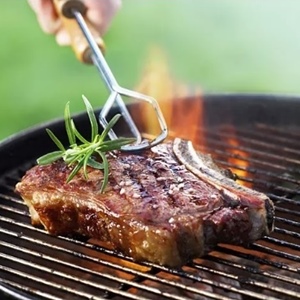The sole act of grilling doesn’t a grill master make! As you probably already know, a lot more effort, experience, and knowledge come into the title of a chef, with grilling being just one of them. In the following article, we would like to address a topic which is often glossed over, unrightfully so. Chefs and cooks around the world always talk about recipes, ingredients, cook time and grill maintenance, but only a couple of them talk about an equally-important thing: quantity.
Making a cookout in your backyard on a beautiful sunny day is easily ruined if you run out of meat to serve. People get nervous, and you start blushing out of embarrassment in front of the guests. It is not that big of a deal if someone’s burger is slightly less salty, but if there are no burgers left, we’re in trouble. That’s why it is important to go through the info we gathered for you, so you can know how much to buy and how much to prepare, according to the type of meat you plan to grill.
1. Standard Portion Sizes
We, as meat eaters, never really found the “ideal” size that fits everyone’s appetites and capacities. People are different, and that is the truth that you will have to deal with sooner rather than later. You can not expect a 9-year old girl to eat as much as a full-grown powerlifter, or a teenager that devours food, due to the whole growing going on.
But, fear not, because there are some general rules about portion sizes and how to look at them, with an average that includes some degree of variations. Meat in its majority consists of protein and fat, and both of these macro-nutrients are rich with taste and calories. Average portion sizes for adults are as follows:
- The recommended size for animal protein source foods is 8 ounces (half a pound) of meat only. An ounce up or down can be tolerated.
- For up to 3 side dishes (protein and non-protein) consider the portion size to round up at 12 – 14 ounces. This will make an average person feel full and satisfied with their food.
- Always account for “special eaters”. By his we mean bring extra for teenagers and people who are into sports, and reduce the portion size for children and toddlers.
Now, for people that tend to eat more than an average person, it is important to leave an extra pound or two in total. No one likes being left out of food on a cookout, but that is equally bad as having a bunch of leftover food lying around after the guests go home.
2. Meat Preparation Yield!
 When it comes to any kind of high-heat meat preparation, especially grilling and searing, you must know what kind of yield you can get out of it. So, essentially, meat yield is the difference between meat mass before and after you grill it.
When it comes to any kind of high-heat meat preparation, especially grilling and searing, you must know what kind of yield you can get out of it. So, essentially, meat yield is the difference between meat mass before and after you grill it.
Let’s put things in perspective first. Whole animals, usually poultry, have the smallest yield. If you want to prepare a turkey that weighs 10 pounds before cooking, you will effectively get 5.5 pounds of meat., which is a yield of 55%. Now, make sure to account for bones and other solids that are not edible.
Where does the mass go, you might ask? Well, high-heat cooking tends to evaporate a lot of liquids from the meat, which is consisted of mostly water and animal fat. Eliminating these liquids in a good ratio is what makes meat tasty, on the side of seasoning, of course.
Getting to know the yield of meat types is important not only for people who cook often but also for people who eat out often. The main difference between a good and a bad restaurant is the quantity of meat on the menu. They will not tell you the yield, but if you get surprised by the small size of a steak, it means that they’ve put the meat mass before the cooking process.
Here are some examples of yield in the most popular types of meat:
- Whole Turkey – 55 %
- Whole Chicken – 55 to 60 %
- Brisket – 50 %
- Average T-bone Steak – 80 to 90 %
- Pulled pork – 50 to 65 %
- Pork shoulder – 60 to 65 %
As you can see, the yield varies not only between the animals you get the meat from, but it also varies depending on the type of meat production and fat percentage. Minced and ground meat will usually have the smallest yield, along with poultry, while high-density meats lie steaks will have the largest yield. All in all, this effect should not be undermined!
There is another system you can use to measure the meat portions for your cookout, and it predates modern times. It is quite accurate, but you should take it with a grain of (sea) salt.
3. The Palm Rule
Even though we never encourage approaching food without precision, the palm rule has proven to be more than useful in many situations. The basic idea feels prehistoric even: the right amount of meat as a protein source should be equal to the size of an open palm of the person eating. This way you got everyone covered with a simple rule.
This system can also be applied for the number of sides with 1 palm size for high carb sides like potatoes, and up to two palm sizes for high fiber low carb food like greens and other veggies. We gave up this little secret, but do not forget that measuring is the king of great taste!
4. How Much Meat Should You Prepare Per Person?
 We’ve covered the essentials, and most importantly learned what meat yield is, but now it’s time to get into the core of the problem: how much meat is actually needed, based on the type of it? These measurements are here to help you decide and adjust your recipes and shopping lists, and they account for an average person and his/her appetite.
We’ve covered the essentials, and most importantly learned what meat yield is, but now it’s time to get into the core of the problem: how much meat is actually needed, based on the type of it? These measurements are here to help you decide and adjust your recipes and shopping lists, and they account for an average person and his/her appetite.
We are going to start from light, and finish with heavy meats! Let’s dig in!
4.1 How Much Fish Per Person?
Grilling fish comes off as the easiest because of its nature, but do not be fooled by the ease of it. In general, for fattier or meatier fishes like salmon, bass, and trout, you can go with 8-ounce pieces of serving size. If we factor in the yield, however, you need to get around 12 ounces of raw fish. The yield of saltwater and freshwater fish differs, with salt water having around 80 %, and freshwater fish having a 70 % yield. So, logically, you will need a slightly larger amount of freshwater fish.
4.2 How Much Chicken Per Person?
Chicken and all poultry meat can be tricky. This comes in due to the different parts of the bird, containing different levels of body fat, muscle, hollow areas, and bones. The easiest to calculate is chicken breasts, especially boneless. Breast portions range from 6 to 8 ounces, and it would be best to serve a 1½ piece as the main serving. If the breasts are not the only meat served, one piece per person, no matter the size, will do the job just fine.
Now, chicken meat that comes with bones inside, count on serving 2 pieces per person, because of the yield lost on the bones themselves. Chicken often comes cut into major pieces, an that’s exactly the way how it should be served. Divide wings, breasts, thighs and drumsticks among your guests, based on preferences (some like non-fat chicken breasts and some prefer fatty drumsticks).
If the prepared whole chicken has a yield of 55 to 60 %, and if prepared cut out that percentage grows to 70 %, so plan accordingly.
4.3 How Much Turkey Per Person?
Similar to chicken meat, turkey is served in 6 to 8-pound portions. But, because of the nature of the meat, people have gotten used to preparing turkey as a whole, rather than as cut out the poultry. If you are aiming to prepare a cut out turkey, one to one and a half piece per person will suffice, but beware, turkey legs and wings are not as popular as chickens are.
Cooking a whole turkey is a different story, and it has a simpler rule: 1 pound of turkey per person. Before you start scratching your head in wonder, we are not talking about serving portions. If you are aiming to feed 10 people, get a 10-pound turkey. Out of all poultry, turkey has the smallest yield of about 50%, and let us not forget the fact that your guests will fight over that juicy turkey breast, so be prepared by getting a huge bird.
4.4 How Much Pulled Pork Per Person?
Pulled pork has a general yield of 50 to 70 %. This is not a lot because of the fact that pulled pork comes from a pig’s shoulder or buttock. This meat type has a lot of intermuscular fat that evaporates easily on higher temperatures.
When preparing pulled pork, you will usually serve it on a plate or in a sandwich bun. If plates are the case, you should aim for ½ to 1/3 pound per person. If you are making pulled pork sandwiches, up to a ½ pound per person will suffice.
If you are making your own pulled pork from a large piece of meat, which we strongly recommend for a richer taste, keep in mind that you can get 4 to 5 pounds of meat out of an 8-pound pork belly or shoulder. This will be more than enough to feed 12 to 15 people.
4.5 How Many Pounds Of Ribs Per Person?
As you might already know, ribs are way easier if counted in pieces, instead of weight, and they are purchased in racks. If we are talking about spare racks, which are larger than baby back ribs, you should consider that a rack can feed 3 or 4 people max.
But if we are talking about baby back ribs, this number gets smaller, because these racks are also smaller. If baby back ribs are what you prefer, consider that a rack can feed 2 people or three tops.
Another thing to factor in if you want to delve into rib cooking: ribs used for stews tend to get smaller yield, so consider getting 30 % more.
4.6 How Much Steak Per Person?
The rule with steaks is simple: the more bone and fat, the smaller the yield. The average yield of standard beef steak is about 75 % with different variations:
- Strip steak, with less fat and almost no bone, has the highest yield of 90 %, so it is the safest bet.
- Rib-eyed and T-bone steaks have a yield of 70 to 78 %, because of the bones and fattier meat content.
- Porterhouse has a 75 % yield, and it can be considered a benchmark.
Considering the fact that steaks are prepared in various conditions, with multiple levels of doneness, you should be prepared to get more. If you are preparing T-bones, an average of 1.5 steaks per person will be needed, which roughly translates to 12 ounces per portion.
4.7 How Much Tenderloin per Person?
Tenderloin tends to be the meat with the highest yield out there. It is not as fat as the other parts of the cow, and it loses up to 10 % in mass during the cooking process. With a yield of 90%, you will be safe by getting an ounce more over the serving portion size.
So, if you want to serve 10 ounces per person, you need to put 11 ounces on the grill, simple as that. Just make sure to check on the quality of the meat. If you see occasional fat traces you do not have to worry, but if these marks appear way too often, increase the weight of the meat you are getting.
4.8 How Much Brisket Per Person?
Brisket is the favorite sandwich ingredient for a lot of people around the world, with a serving of 4 ounces per sandwich. Now, let us be honest for a moment and admit the fact that we never actually prepare brisket in smaller sizes, and the go big or go home rule applies perfectly here.
With the yield of 50 to 60 % only, you will need to double the weight of brisket meat you want to prepare. For a larger cookout, you will serve at least 8 ounces of brisket per person, meaning that you need to get 10 pounds of meat for 10 people. This meat is pretty fat, and it will shrink its size by half, so be prepared.
4.9 How Much Meat Per Person In Order To Make Skewers?
It depends. You can put any type of meat on a skewer if you are skilled enough, but one rule applies: the skewer construction and fillers (veggies, mushrooms, etc.) make the meat retain some of its liquid content. Essentially, this translates to a slightly larger yield (up to 10 % more, depending on your skill).
If you plan to use pork on a skewer, for an 8-ounce serving you will need about 10 to 12 ounces of pork meat, as low in fat as you can find. The fatter the pork, the more you will need.
In the case of beef, for an 8-ounce skewer, you will need up to 10 ounces of beef, again the less fat the better.
5. More Tips For The Road
The sizes and weights we talked about in the section above are not to be taken literally, and that is why we would like to encourage you to experiment a little. Different people have different appetites and wishes, and backyard cooks often get demoralized when they don’t hit the targeted meat amount. DO NOT get discouraged, and we promise you that right after the first cookout you will know much more about your guests and general weight of the meat you need to buy.
If you want to practice on the quantity, makes sure the quality is there too. Start with simpler recipes, get necessary hardware(like an outdoor propane griddle, offset smoker, kamado grill, etc.) and build up from there. Some highly-advanced recipes can change the yield of the meat, and some marinades can prevent the water and fat from escaping the meat structure. It is nothing a little experimentation can’t solve. After all, your guests and your taste buds will be grateful.
Wrap Up
We talked about running out of food because of wrong assessments or fattier meats, but let’s not forget that excessive leftovers are not a good thing too. Like any skill in life, cooking needs some time too, but the fortune of developing chef skills are the tastes and flavors you are going to discover, so savor that and grow as a cook.
There are no definite sizes or portions, and we were here just to give you a slight idea. You best friend in quality and quantity is your own gut, so don’t ignore it!
